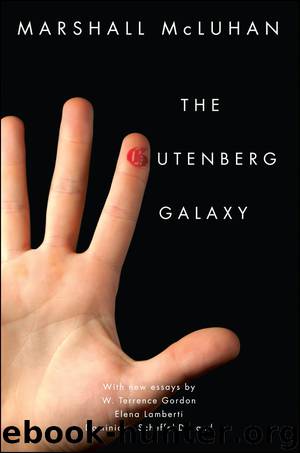The Gutenberg Galaxy: The Making of Typographic Man by Marshall McLuhan

Author:Marshall McLuhan [McLuhan, Marshall]
Language: eng
Format: epub
Tags: LIT007000, HIS006000
Publisher: University of Toronto Press
Published: 2011-09-04T16:00:00+00:00
The invention of typography confirmed and extended the new visual stress of applied knowledge, providing the first uniformly repeatable COMMODITY, the first assembly-line, and the first mass-production.
The invention of typography, as such, is an example of the application of the knowledge of traditional crafts to a special visual problem. Abbott Payson Usher devotes the tenth chapter of his History of Mechanical Inventions to “The Invention of Printing,” saying (p. 238) that more than any other single achievement, it “marks the line of division between medieval and modern technology … We see here the same transfer to the field of the imagination that is clearly evident in all the work of Leonardo da Vinci.” From now on “imagination” will tend more and more to refer to the powers of visualization.
The mechanization of the scribal art was probably the first reduction of any handicraft to mechanical terms. That is, it was the first translation of movement into a series of static shots or frames. Typography bears much resemblance to cinema, just as the reading of print puts the reader in the role of the movie projector. The reader moves the series of imprinted letters before him at a speed consistent with apprehending the motions of the author’s mind. The reader of print, that is, stands in an utterly different relation to the writer from the reader of manuscript. Print gradually made reading aloud pointless, and accelerated the act of reading till the reader could feel “in the hands of” his author. We shall see that just as print was the first mass-produced thing, so it was the first uniform and repeatable “commodity.” The assembly line of movable types made possible a product that was uniform and as repeatable as a scientific experiment. Such a character does not belong to the manuscript. The Chinese in printing from blocks in the eighth century, had been mainly impressed by the repetitive character of print as “magical” and had used it as an alternative form to the prayer wheel.
William Ivins has made a more thorough analysis of the esthetic effects of prints and typography on our human habits of perception than anybody else. In Prints and Visual Communication (pp. 55–6) he writes:
Each written or printed word is a series of conventional instructions for the making in a specified linear order of muscular movements which when fully carried out result in a succession of sounds. These sounds, like the forms of the letters, are made according to arbitrary recipes or directions, which indicate by convention certain loosely defined classes of muscular movements but not any specifically specified ones. Thus any printed set of words can actually be pronounced in an infinitely large number of ways, of which, if we leave aside purely personal peculiarities, Cockney, Lower East Side, North Shore, and Georgia, may serve as typical specimens. The result is that each sound we hear when we listen to anyone speaking is merely a representative member of a large class of sounds which we have agreed to accept as symbolically identical in spite of the actual differences between them.
Download
This site does not store any files on its server. We only index and link to content provided by other sites. Please contact the content providers to delete copyright contents if any and email us, we'll remove relevant links or contents immediately.
Cecilia; Or, Memoirs of an Heiress — Volume 1 by Fanny Burney(32503)
Cecilia; Or, Memoirs of an Heiress — Volume 2 by Fanny Burney(31913)
Cecilia; Or, Memoirs of an Heiress — Volume 3 by Fanny Burney(31898)
The Great Music City by Andrea Baker(31759)
We're Going to Need More Wine by Gabrielle Union(19004)
All the Missing Girls by Megan Miranda(15784)
Pimp by Iceberg Slim(14438)
Bombshells: Glamour Girls of a Lifetime by Sullivan Steve(14024)
For the Love of Europe by Rick Steves(13627)
Talking to Strangers by Malcolm Gladwell(13297)
Norse Mythology by Gaiman Neil(13281)
Fifty Shades Freed by E L James(13189)
Mindhunter: Inside the FBI's Elite Serial Crime Unit by John E. Douglas & Mark Olshaker(9266)
Crazy Rich Asians by Kevin Kwan(9224)
The Lost Art of Listening by Michael P. Nichols(7456)
Enlightenment Now: The Case for Reason, Science, Humanism, and Progress by Steven Pinker(7274)
The Four Agreements by Don Miguel Ruiz(6704)
Bad Blood by John Carreyrou(6584)
Weapons of Math Destruction by Cathy O'Neil(6220)
